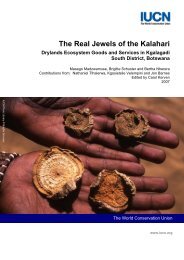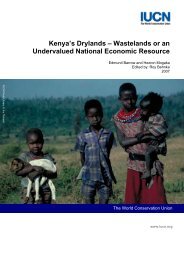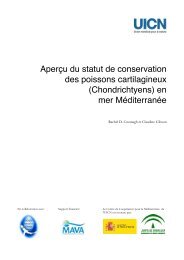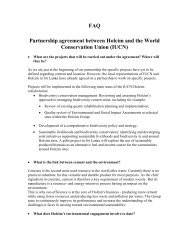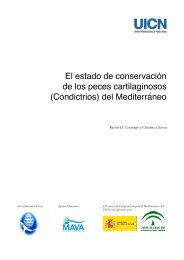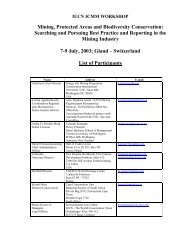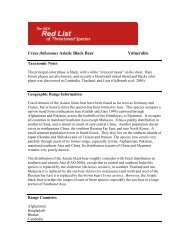1. IntroductionChondrichthyans are a relatively small (approximately 1,200species) evolutionarily-conservative group that hasfunctioned successfully in diverse ecosystems for over400 million years. Despite their evolutionary success,many chondrichthyans are increasingly threatened withextinction as a result of human activities and theconservative life history traits of this group of fishes.Generally, chondrichthyans are slow growing and late tomature, with low fecundity. <strong>The</strong>se characteristics resultin very low rates of potential population increase withlittle capacity to recover from overfishing (direct orindirect) and other threats such as pollution and habitatdestruction (Fowler et al. 2005).In 2003, the IUCN World Conservation Union’s <strong>Shark</strong>Specialist Group (SSG), in collaboration with the IUCNCentre for Mediterranean Cooperation, established aregional group of experts to work more coherentlytowards improved conservation and management ofchondrichthyan fishes in the Mediterranean. One of theprimary aims of the group was to assess the threatenedstatus of each chondrichthyan species that occurs in theMediterranean by applying the IUCN Red List criteria. Thiswork constitutes part of the SSG’s global programme tocomplete IUCN Red List assessments for all chondrichthyanfishes. A summary of the results of the Mediterraneanassessments is presented in this report, highlightingspecies of conservation concern as well as those of leastconcern. It is envisaged that the information containedwithin this report will facilitate further development andimproved implementation of the United NationsEnvironment Programme (UNEP) Mediterranean ActionPlan (UNEP MAP RAC/SPA 2003) and the development ofpriority research, conservation and management actions forthe region.This IUCN overview summarises the SSG’s full report(Cavanagh et al. in prep.), which provides an in-depthoverview of regional issues and contains detailedsummaries of IUCN Red List assessments for all chondrichthyanfishes that occur in the Mediterranean Sea.1.1 Chondrichthyan fishes inthe Mediterranean<strong>The</strong> Mediterranean Sea covers an area of approximately2.5 million km 2 (about 0.7% of the world’s ocean surfacearea) and has an average depth of 1,500m (reaching5,200m at its deepest point in the Ionian Sea). <strong>The</strong>coastline extends for 46,000km and is bordered by21 countries (Zenetos et al. 2002).Figure 1. Map of the Mediterranean Sea and surrounding countries.1
Although the Mediterranean is a semi-enclosed sea, thechondrichthyan fish fauna is relatively diverse with anestimated 80 species (approximately 7% of total livingchondrichthyans), comprising 45 species of <strong>sharks</strong> from 17families, 34 batoid species from nine families and one speciesof chimaera (Compagno 2001; Compagno et al. 2005;Compagno in prep a; Compagno in prep b; Serena 2005).An illustrated checklist of all 80 species of chondrichthyansthought to occur in the Mediterranean Sea is provided inAppendix 1. However, this report focuses on 71 of the 80species as the occurrence of the remaining nine species withinthe Mediterranean is either infrequent, questionable, orcannot be confirmed due to taxonomic uncertainty (e.g.shortnose spurdog Squalus megalops), and these ninespecies are not known to breed within the region. <strong>The</strong>yinclude species which rarely occur in the Mediterranean atthe very edge of their range (e.g. milk shark Rhizoprionodonacutus), occasional visitors from the Atlantic (e.g. silky sharkCarcharhinus falciformis), or vagrants from the Red Seathat have travelled through the Suez Canal (e.g. blacktip reefshark Carcharhinus melanopterus).Endemism of chondrichthyans in the Mediterranean islow, with only four batoid species (Maltese skateLeucoraja melitensis, speckled skate Raja polystigma,rough ray R. radula and giant devilray Mobula mobular)that could be considered endemic (Serena 2005). Withinthe Mediterranean, the distribution of chondrichthyanfishes is not homogenous (Serena 2005). Some areas areconsidered critical habitat for chondrichthyans. Forexample, Tunisian waters provide a nursery area for whiteshark Carcharodon carcharias. Aggregations of baskingshark Cetorhinus maximus, have been observed in thenorthern Balearic region, the Northern Adriatic and theTyrrhenian Sea (Walker et al. 2005). A strong correlationbetween the presence of C. maximus, chlorophyllconcentration and prey abundance in these areas indicatethey are important feeding sites (Sims 2003; Sims et al.2003). Some species have a restricted range within theMediterranean, for example a small population of thesmalltooth sand tiger shark Odontaspis ferox seemsresident in a particular area off Lebanon (Walker et al.2005). <strong>The</strong> low rate of exchange between isolatedpopulations, for example angelshark Squatina spp.populations around the Balearics, leaves them especiallyprone to local depletion, given that recolonisation rateswill be extremely low (Massutí and Moranta 2003).1.2 Overview of threats to MediterraneanchondrichthyansAvailable evidence indicates that chondrichthyans in theMediterranean are generally declining in abundance,diversity and range and are possibly facing a worsescenario than chondrichthyan populations elsewhere in theworld (Walker et al. 2005). <strong>The</strong>se declines can be attributedto a number of factors, including the life history characteristicsof chondrichthyans in combination with the semi-enclosednature of the Mediterranean Sea and intense fishing activitythroughout its coastal and pelagic waters; effects of habitatloss; environmental degradation; and pollution (Stevens etal. 2005; Walker et al. 2005). Large coastal species (whichare biologically the most vulnerable to exploitation) andspecies that occur in areas subjected to prolonged and/orintensive fishing pressure are of particular concern. Suchspecies include the sand tiger shark Carcharias taurus, whiteskate Rostroraja alba and porbeagle Lamna nasus.1.2.1 Life history characteristicsAlthough considerable variation occurs, chondrichthyansexhibit strongly K-selected life history strategies especiallywhen compared with teleost fishes (Cailliet et al. 2005).Chondrichthyans are generally slow growing, late tomature, have low fecundity and productivity, longgestation periods, high natural survivorship of all ageclasses and long life (Cailliet et al. 2005; Camhi et al.1998). <strong>The</strong>se biological traits result in low reproductivepotential and low capacity for population increase formany species. Such characteristics have seriousimplications for chondrichthyan populations; limitingtheir capacity to sustain fisheries and recover fromdeclines (Cailliet et al. 2005; Camhi et al. 1998).1.2.2 Fisheries<strong>The</strong> commercial value of chondrichthyans is lowcompared to that of teleost fishes and shellfishes in theMediterranean. Currently chondrichthyans represent0.78% of the total landings in the Mediterranean Sea(FAO 2006). Between 1970 and 1985, landings ofchondrichthyan fishes in the Mediterranean, as reportedto the Fisheries and Agriculture Organization of the UnitedNations (FAO), increased from 10,000t to 25,000t.Subsequently, reported landings declined to 1,000t by2004 (FAO 2006; SGRST 2003).Benthic trawl effort has increased in the shelf and slopearea of the Mediterranean over the past 50 years (Aldebert1997). Increased fishing intensity and technologicaladvancement of fishing gear has resulted in a decline inmany chondrichthyan species commercially captured bytrawls in the north-western Mediterranean (Walker et al.2005). Several demersal species are utilised commercially,while only a few pelagic species are marketed. <strong>The</strong>major chondrichthyan fishing countries within theMediterranean are Turkey, Tunisia, Greece, Italy and Spainand the species most commonly taken in coastal fisheries are:smoothounds Mustelus spp., skates Rajids, cat<strong>sharks</strong>Scyliorhinus spp., dogfish Squalus spp., eagle raysMyliobatids and whiptail stingrays Dasyatids (Walker et2



